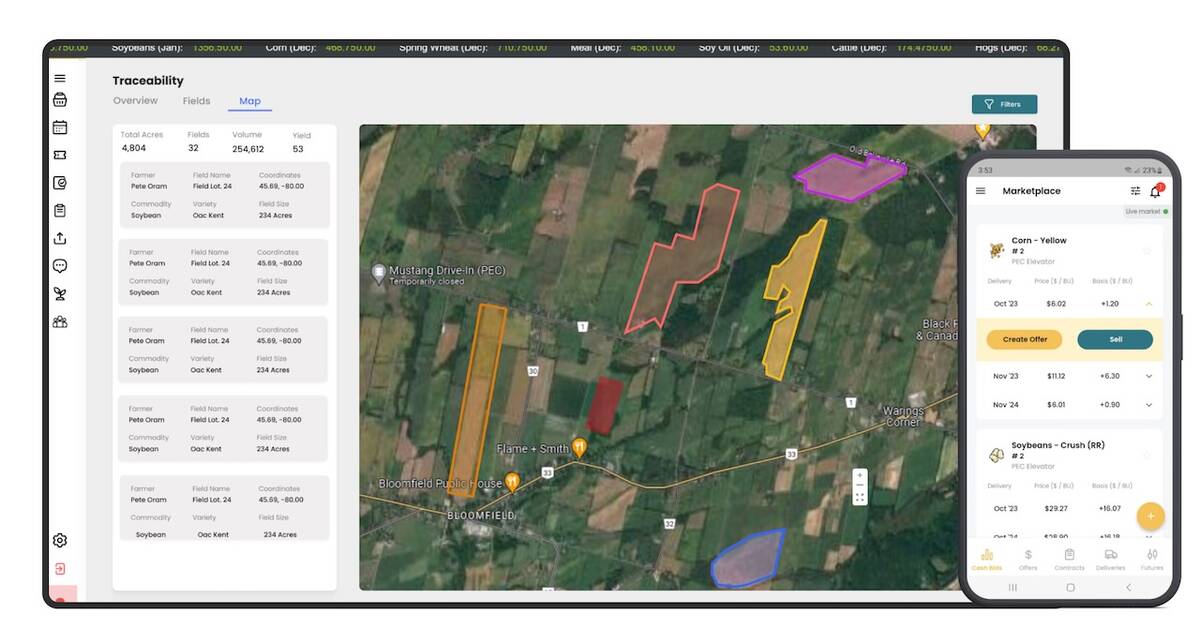Farmers looking to maximize crop yields need to keep a close eye on the gauges during the growing season.
In June, A&L Canada Laboratories hosted a webinar that explored effective plant tissue testing strategies, highlighting the importance of proactive tissue sampling and plant monitoring programs to address nutrient deficiencies before they become yield-limiting.
A&L Canada Laboratories president Greg Patterson says giving a crop the nutrients it needs is the most basic building block.
“It’s like the fuel gauge in your crop, and each one of those nutrients is a fuel that the crop needs, and we want to make sure we keep on top of the tanks so that the crop doesn’t run short,” he said.
Read Also

Ontario company Grain Discovery acquired by DTN
Grain Discovery, an Ontario comapny that creates software for the grain value chain, has been acquired by DTN.
Managing crop diseases has become increasingly challenging for farmers as pesticide resistance and lower-quality soils make achieving higher yields more difficult.
In June, A&L Canada Laboratories hosted a webinar that explored effective plant tissue testing strategies, highlighting the importance of proactive tissue sampling and plant monitoring programs to address nutrient deficiencies before they become yield-limiting.
Patterson believes that prevention and early analysis are key to ensuring effective and accurate disease treatment.
“Why would we wait to find a deficiency before we start treating it? If [farmers have] done a good job with understanding their soil test site-specific sampling of their fields, so they see the variability, they have historical information on nutrient deficiencies,” he said.
Patterson noted that an effective plant monitoring program monitors the correctives that have been put in place and makes sure they’ve done enough. He said that this will help identify if the farmer needs to increase their correctives to deal with deficiencies.
Subtle differences
How nutrient deficiencies play out can at times be a delicate dance.
There’s the obvious ones, Patterson said, like nitrogen.
“We have a real love affair for nitrogen, which we pay attention to, because we see the instant results of supplying it,” he said.
Other nutrients like phosphate or potassium or zinc or manganese deficiencies aren’t as plainly seen.
“They’re not quite that dramatic,” he said.
They may or may not happen, depending on variables like the weather during the growing season or the farmer’s crop choice.
Patterson added not understanding soil variability and addressing deficiencies through a balanced fertility program will leave the field vulnerable to disease.
He pointed to the 2024 growing season, which saw a cold, wet spring that triggered a deficiency in both potash and manganese.
“The challenge is we have to do a better job with soil sampling and understanding the variability of the fields we’re working with so that we can address them both with a ground application program and use foliar to supplement any problems,” he said. “The issue with foliar feeding is that it does not correct problems. It helps us top up the tank and helps us deal with in-season problems. And we should not be using foliar programs as a rescue treatment. We should be addressing the soil condition and then using our foliars to supplement a well-balanced fertility program that we put in the field.”
Patterson said farmers need a proactive nutrient program for locating and identifying potential deficiencies. He added it is not just about finding the root cause of deficiencies but understanding the broader farming practices contributing to them.
Patterson doesn’t believe that climate change should be the main driver of crop analysis; rather, he said, farmers should note that the climate is always changing and weather will always be a factor in how crops perform.
“One thing we can’t do as farmers in farming is we can’t blame the weather,” he said. “Mother Nature has a big impact on what we do, but we can’t blame Mother Nature. We have to put things in place so that we can weather the storm.”
Balanced approach
Patterson said this is done through balanced fertility, which improves the field’s ability to withstand swings in environmental conditions.
When it comes to defining an individual farm’s sampling schedule, Patterson believes that farmers need to take a proactive approach and sample based on individual crop and field needs.
“I tell farmers using our plant monitoring program, it’s up to you how many samples you take or how few. If you have a problem field, set up a monitoring station in that part of the field and take four or five samples over the growing season and deal with it,” he said.
He stressed that the soil sample was the starting point, and tissue sampling augments that snapshot with a growing season view, to “respond to or address some of those deficiencies you’ve seen in the past and observations in the field.”
He warned that if a farmer is not going to put together a well-developed fertility program based on this understanding of the soil, tissue samples are not going to be enough to mitigate risk. He said that samples should be adjusted through the season to better understand environmental patterns year over year.
Universal
Patterson reminded farmers that despite specific geographical conditions that may exist in a particular region, it is still critical to understand how nutrients will perform.
“I don’t care if you grow the crop here in Southwestern Ontario or you grow it on the moon; the crop still needs the same amount of nutrients to perform what it needs, and nutrient levels do not change,” he said. “It doesn’t matter where you grow the crop; the same conditions and parameters do apply. The plant takes up nutrients the same way. So the tissue sample analysis is the same no matter where you grow it. They’re based on field research for that particular crop.”
He added that results are all yield-related, noting that the worst tissue analysis is going to come off the best crop because as the crop uses nutrients to produce yield, it’s seeking nutrients that will show up in that tissue analysis.
“We want to be there when the crop is running short on that particular nutrient so we can supplement that nutrient so we don’t run out of that nutrient and have an impact on the overall quality of yield,” he said. “Our belief is, if you can maintain a certain quality in that crop, yield will come with it.”
He said that if this approach is taken and the right level of nutrition is provided, then those crop needs will be met and yields will meet expectations.
“You can sell a crop that has good quality and lower yield, but you can’t sell a high-yield crop that has no quality,” he said.













